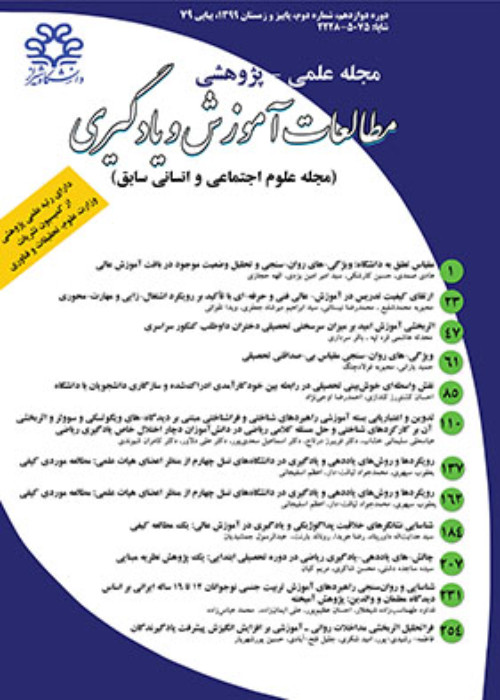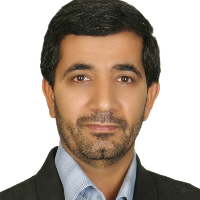Academic buoyancy and Perception of Family Communication Patterns: Mediatory role of Self- efficacy
Author(s):
Abstract:
Introduction Human beings go through ups and downs of life full of challenges and opportunities. A great proportion of life's challenges is linked to adolescence among which one can refer to academic challenges (e.g., low grades, levels of stress, threatening of confidence due to performance, decrease in motivation and interaction, etc.). As one of these challenges, academic period is a period of life during which rapid cognitive and social changes occur (Spear1, 2000). Thus, researchers interested in education have paid attention to adaptation and compatibility with opportunities and challenges of life. Within different viewpoints, collections of capabilities and aptitudes which influence this kind of compatibility have been paid attention to. Academic buoyancy is among those capabilities and aptitudes which make individuals compatible against threats, impediments, difficulties, and pressures in the academic environment. Academic buoyancy reflects academic tolerance within the framework ofpositive psychological field. Academic buoyancy is defined as student's ability in successfully dealing with impediments and academic challenges which are considered as usual in academic life (Martin & Marsh, 2008). Also, academic buoyancy refers to a positive compatible response adaptive to different challenges and impediments which are experienced through the continuous and ongoing academic field (Putwain, Connors, Symes, & Douglas-Osborn, 2011). Academic buoyancy antecedents in different levels are psychological factors, schools and engagement factors in the education process, and family and peer factors (Martin & Marsh, 2008). Among family and peer factors, one can name family support and its communication patterns. Many experimental observations (such as Alva, 1991; McMillan & Reed, 1994; Masten & Coatsworth, 1998; Voydanoff & Donnelly, 1999 & Wayman, 2002) support the role of these factors in increasing compatibility, competence and success. Among the psychological factors, self-efficacy can be considered as one of the factors influencing academic buoyancy which was proposed by Bandura within social-cognitive theory (Basol, 2010). Bandura (2001) recognizes self efficacy as the most important factor determining activities we choose. From Bandura, Pastorelli, Barbaranelli & Caprara's (1999) viewpoint, self-efficacy is a multi-dimensional variable and should be evaluated within different fields. In this sense, they consider three main areas of academic self efficacy, social self-efficacy, and emotional self-efficacy. Academic self-efficacy is related to one's feeling capable of managing learning activities, knowing educational subjects, and fulfilling academic objectives (Muris, 2001). Social self-efficacy refers to one's capacities in confronting social challenges, feeling of capability in one's relationships with peers, and the ability to manage incompatibility among individuals (Muris, 2001). Muris (2001) defines emotional self-efficacy as a perceived ability of overcoming negative emotions by a person. Self-efficacy as a personal variable has a significant role in one's encountering of life issues (Brown & Anivy, 2005; Schwarzer & Jerusalem, 1995) and can be an influential factor in academic and educational situations (Salami & Ogundokun, 2009). Accordingly, the present study was conducted to discover the effect of psychological and contextual factors (family communication patterns and self-efficacy) as the main elements on the degree of student's academic buoyancy. Research questionsThe present study aims at investigating the self-efficacy's mediatory role in the relation of family communication patterns with academic buoyancy. Therefore, the present study attempts to answer the following questions:- Is it possible to predict student's academic buoyancy based on family communication patterns? - Is it possible to predict student's self-efficacy according to family communication patterns?- Can self-efficacy have the mediatory role between family communication patterns as endogenous variable and academic buoyancy as exogenous variable?MethodThe study's design is a correlational one with family communication patterns as endogenous variable, self-efficacy as mediatory variable, and academic buoyancy as the final exogenous variable. Overall, 337 students (176 females and 161 males) of a high school located in Mehriz city participated in the study. These students were chosen through multi-stage random cluster sampling. In gathering information, three instruments were utilized: Revised Scale of Family Communication Patterns (Fitzpatrick & Ritchie, 1994), Self-Efficacy's Dimensions Questionnaire (Muris, 2001), and Academic Buoyancy Questionnaire (Hoseinchari & Dehghanizadeh, 1391). All the three instruments enjoyed appropriate reliability and validity. ResultsAnalysis of the data using path analysis and based on Baron and Kenny (1986) showed that the conversation dimension directly predicts academic buoyancy and self-efficacy dimensions and that self efficacy dimensions can play a mediatory role between the family communication patterns and student's academic buoyancy. Discussion In general, the findings of the study highlight the direct and indirect effect of family communication patterns on the mediatory role of self-efficacy. Not only self-efficacy has a direct effect on academic buoyancy, but it also acts as a mediatory variable between the conversation orientation and academic buoyancy. Effective relationship with parents leads to the creation of and increase in self-efficacy and with this increase, confidence is built within students. About the significance and influence of self efficacy beliefs, Bandura (2001) maintains that none of the individual's cognitive beliefs is as constructive as efficacy in managing individual's compatibility performance in dealing with difficulties and stressful conditions. Students with high self-esteem in their performance appear as energetic and believe that they can overcome difficulties and challenges. Such a belief in personal capabilities in confronting environmental stressful stimuli is accompanied by compatible performances of buoyancy.
Keywords:
Language:
Persian
Published:
Studies in Learning & Instruction, Volume:4 Issue: 2, 2012
Page:
21
magiran.com/p1151252
دانلود و مطالعه متن این مقاله با یکی از روشهای زیر امکان پذیر است:
اشتراک شخصی
با عضویت و پرداخت آنلاین حق اشتراک یکساله به مبلغ 1,390,000ريال میتوانید 70 عنوان مطلب دانلود کنید!
اشتراک سازمانی
به کتابخانه دانشگاه یا محل کار خود پیشنهاد کنید تا اشتراک سازمانی این پایگاه را برای دسترسی نامحدود همه کاربران به متن مطالب تهیه نمایند!
توجه!
- حق عضویت دریافتی صرف حمایت از نشریات عضو و نگهداری، تکمیل و توسعه مگیران میشود.
- پرداخت حق اشتراک و دانلود مقالات اجازه بازنشر آن در سایر رسانههای چاپی و دیجیتال را به کاربر نمیدهد.
In order to view content subscription is required
Personal subscription
Subscribe magiran.com for 70 € euros via PayPal and download 70 articles during a year.
Organization subscription
Please contact us to subscribe your university or library for unlimited access!



